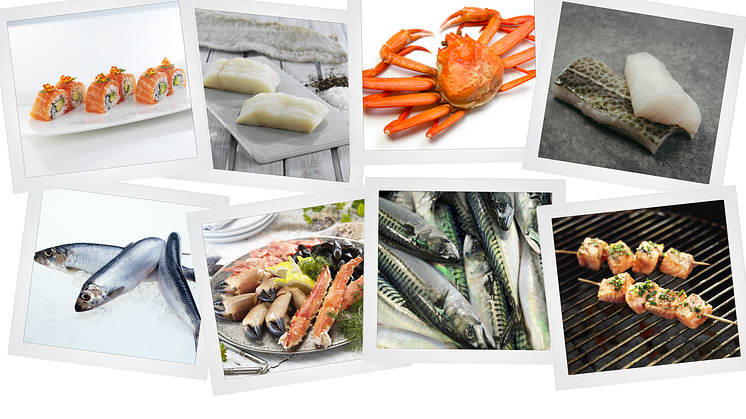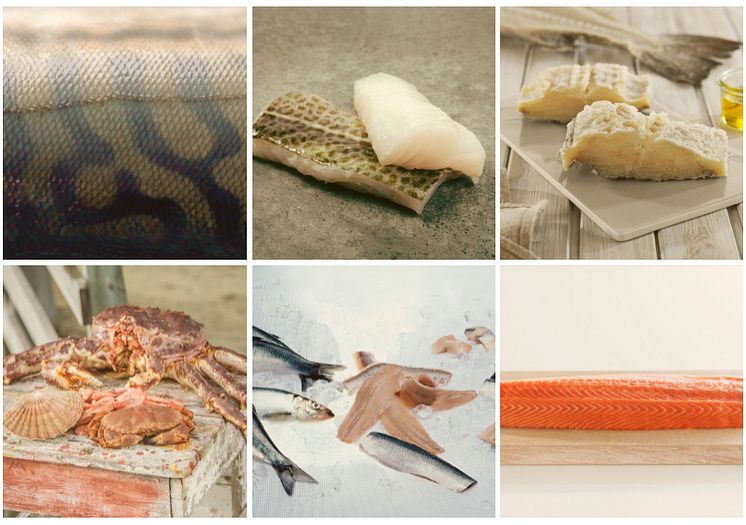
Press release -
Norwegian seafood exports fall for the first time in 18 months
For the first time since September 2018, Norway has experienced a fall in the value of its seafood exports. In April, 183,000 tonnes of Norwegian seafood was exported to a value of NOK 8.2 billion. This is a decrease of NOK 666 million, or 8 per cent, compared with April 2019. Volumes were also down 7 percent compared to April 2019.
“A significant fall in demand for salmon and whitefish in April as a result of the corona crisis is the main reason. This can be evidenced by the decline of the restaurant segment and increased air freight costs for the transportation of fresh products to overseas markets”, says Director of Market Insight and Market Access at the Norwegian Seafood Council, Tom-Jørgen Gangsø.
So far this year, NOK 36.7 billion of Norwegian seafood has been exported. This is an increase in value by 2.2 billion, or 6 per cent, compared to the same period last year.
“This year can be split in two for seafood exports, before and after the corona crisis. 2020 started off well with a strong increase in value due to increased demand for Norwegian seafood products. This positive trend came to an abrupt end within the introduction of measures to reduce the spread of the coronavirus, which is why we are seeing exports fall for the first time in 18 months”, says Director of Market Insight and Market Access in the Norwegian Seafood Council, Tom-Jørgen Gangsø.
Significant uncertainty
Despite a marked weakening of the Norwegian krone, the export value of Norwegian seafood fell by 8 per cent in April.
"Local measures to reduce the spread of the virus lead to changes in the flow of goods. This is especially true for fresh fish. For example, we see growth in a market like Spain, while there is a decline in Italy. We also find that the corona crisis has led to layoffs and increased unemployment globally. There is considerable uncertainty about how weakened purchasing power will affect demand for Norwegian seafood in the long run. We are already seeing a fall in demand for clipfish, including in Brazil" says Gangsø.
Fall in export value for salmon
83,100 tonnes of salmon were exported to a value of NOK 5.4 billion in April. This is a 3 per cent reduction in volume, while the value fell by NOK 813 million, or 13 per cent, compared with April last year.
“Reduced prices due to lower demand and increased air freight costs have led to a fall in export value in April”, says Seafood Analyst Paul T. Aandahl of the Norwegian Seafood Council.
So far this year, 334,600 tonnes of salmon have been exported, worth NOK 23.7 billion. This represents an increase in the volume of 1 per cent, while the value has increased by NOK 862 million, or 4 per cent. The average price for fresh whole salmon in April was NOK 57.71 per kg, compared to NOK 68.45 per kg in April last year. Poland, France and the United States were the largest importers of salmon from Norway in April.
Differences between markets
There is a large change in the flow of goods to individual markets. Some markets have, to a greater extent than others, been able to compensate for reduced restaurant consumption with increased consumption at home. In markets such as China, Hong Kong, Taiwan and South Korea, consumption of Norwegian salmon is increasing, while it is declining in tourism-dependent markets such as Thailand and Singapore.
“In Europe, the supply of salmon is increasing in markets that largely refine Norwegian salmon, such as Poland and Lithuania. Exports also increase to consumer markets such as Spain and Germany, while falling to Italy and France. This happens a lot because of local measures that make normal sales of fresh fish challenging. Reduced freedom of movement prevents consumers from shopping as normal, thus shifting sales of fresh salmon towards products with longer shelf life. The result is that we will not be compensated for the loss of the restaurant sector”, says Seafood Analyst Paul T. Aandahl with the Norwegian Seafood Council.
Growth in Spain
Spain is one of the markets that has grown the most in value and volume so far this year. The export figures for April show that this growth is continuing. This is unique since Spain has been severely affected by the corona crisis.
“Much is due to Norwegian seafood's strong position in Spain, especially when it comes to salmon. Norwegian salmon has in just a few years become the number one favourite fish of the Spaniards, both in the restaurant and at home, for every day and for parties. In the wake of the corona crisis, Spanish salmon consumption has shifted from the restaurant market to the dinner table at home”, says the Norwegian Seafood Council's fisheries envoy to Spain, Bjørn-Erik Stabell.
Unlike other countries, the fresh produce discs in Spain have been open during the corona crisis.
“In marketing campaigns, we have in recent weeks shown the Spaniards how to make healthy and good Norwegian seafood at home. In a survey, 40 per cent of Spaniards say that healthy food has become more important to them during the state of emergency, and there appears to have been an increased demand for Norwegian seafood”, says the Norwegian Seafood Council's fisheries envoy to Spain, Bjørn-Erik Stabell.
Fall in export value for Norwegian trout
In April, 4,200 tonnes of trout were exported to a value of NOK 234 million. Volume increased by 13 per cent, while the value fell by NOK 36 million, or 13 per cent, compared with April last year. So far this year, 19,800 tonnes of trout have been exported to a value of NOK 1.2 billion. There is an increase in the volume of 35 per cent, while the value increased by NOK 162 million, or 16 per cent. The US, Japan and Ukraine were our biggest trout markets in April.
Challenges in the clipfish markets
5,600 tonnes of clipfish worth NOK 295 million were exported in April. Volume increased by 16 per cent, while value increased by NOK 63 million, or 27 per cent, from April last year.
“The growth in April is due to increased exports of saithe. There is considerable growth in both Congo and Congo-Brazzaville. At the same time, development in several other markets is challenging. Buying power and demand in Brazil have already been hit hard by both a weak oil price and the corona crisis, which has led to minimal exports of both codfish and cod to this market over the past two months. The value growth for clipfish is also largely driven by a weak Norwegian kroner”, says Seafood Analyst Ingrid Kristine Pettersen from the Norwegian Seafood Council.
In some African countries, large stocks at the end of last year led to lower exports in the first months of 2020.
“Nevertheless, there has been good demand in some markets in Africa. Exports to Congo Brazzaville and DRC rose sharply in April. The development of purchasing power in the future is, of course, uncertain given the demanding situation in this market”, says the Norwegian Seafood Council's fisheries envoy to Central and West Africa, Trond Kostveit.
So far this year, 28,000 tonnes of clipfish have been exported to a value of NOK 1.5 billion. This is a 6 per cent reduction in volume, while the value increased by NOK 168 million, or 13 per cent. Portugal, the Dominican Republic and Congo-Brazzaville were our biggest markets in April.
Salted fish exports are impacted
In April, 3,500 tonnes of salt fish were exported to the value of NOK 247 million. The volume fell by 11 per cent, while the value increased by NOK 12 million, or 5 per cent, compared with April last year.
“The fall in the export volume of salted fish in April must also be seen in the context of the corona crisis. There is uncertainty about future demand developments in the Portuguese market and in Portuguese export markets, such as Brazil. Price growth can largely be attributed to a weak Norwegian kroner”, says Seafood Analyst Ingrid Kristine Pettersen from the Norwegian Seafood Council.
So far this year, 11,800 tonnes of salted fish have been exported to the value of NOK 756 million. There is an increase in the volume of 13 per cent while the value fell by NOK 166 million or 28 per cent. Portugal, Spain and Canada were our biggest markets in April.
Low season for dried fish
In April, 123 tonnes of whole cod, saithe and tusk stockfish were exported to a value of NOK 22 million. The volume fell by 53 per cent and the export value fell by NOK 28 million, or 56 per cent, compared with April last year.
“We are now in a low season for dry fish exports. However, challenges in the Italian market are the main explanation for the fall in exports in both March and April. Dry fish sales are affected both by the closure of the restaurant segment and the fact that dry fish is to a small extent available in modern channels such as hypermarkets and supermarkets. There is a great deal of excitement associated with future developments that will be important when sales of this year's production start in the fall”, says Seafood Analyst Ingrid Kristine Pettersen with the Norwegian Seafood Council.
So far this year, 1,333 tonnes of whole cod, saithe and chives have been exported worth NOK 229 million. This is a decrease in volume of 11 per cent, while the value fell by NOK 31 million, or 12 per cent. Italy and Nigeria were our biggest markets in April.
Reduction for skrei
7,300 tonnes of fresh cod were exported including skrei to a value of NOK 313 million. This is a 15 per cent reduction in volume, while value fell by NOK 43 million, or 12 per cent, from April last year. So far this year, 30,300 tonnes of fresh cod including skrei have been exported to a value of NOK 1.4 billion. There is a 10 per cent reduction in volume, while the value fell by NOK 29 million, or 2 per cent. Of this, skrei represents 5,500 tonnes, which is a 17 per cent reduction.
The value of skrei exports was NOK 264 million, down NOK 26 million, or 9 per cent. Denmark, the Netherlands and Poland were the largest recipients of fresh cod in April.
“At the beginning of the year, we were anticipating a new record season for the scream, but a relatively sharp fall in demand in March and April due to the closure of, among other things, the restaurant segment has had a negative impact on export volumes. Relatively good demand in the grocery trade in Spain has been positive, but overall demand and prices, measured in euros, have fallen during the latter part of the fishing season. Developments in purchasing power in the future also create great uncertainty regarding the demand for fresh cod in the future”, says Seafood Analyst Ingrid Kristine Pettersen with the Norwegian Seafood Council.
Currency effects for frozen cod
In April, 5,600 tonnes of frozen cod were exported to a value of NOK 286 million. This is a 5 per cent reduction in volume, while the value increased by NOK 33 million, or 13 per cent. So far this year, 28,800 tonnes of frozen cod have been exported to the value of NOK 1.4 billion. There is a 7 per cent reduction in volume, while the value increased by NOK 56 million, or 4 per cent. China, France and the United Kingdom were the largest recipients of frozen cod in April.
“There has been a fall in exports of frozen whole cod to the UK in April. This is partly because last April's month was a very strong export month to the UK, as fears of closed borders in connection with Brexit led to a stock build-up”, says Seafood Analyst Ingrid Kristine Pettersen with the Norwegian Seafood Council.
On the other hand, in April this year there was growth in further processing markets such as Lithuania and the Netherlands.
“This can be seen in the context of an increase in demand for prepackaged, frozen and processed products for home consumption in several markets. Still, it does not seem to offset the decline in demand from the restaurant segment. This is reflected in falling export prices, measured in US dollars, for example. Value growth in April, measured in Norwegian kroner, can therefore be largely attributed to the weak Norwegian kroner”, says Seafood Analyst Ingrid Kristine Pettersen with the Norwegian Seafood Council.
Large growth in export value for herring and mackerel
17,200 tonnes of herring were exported to a value of NOK 265 million in April. This is an increase in volume of 56 per cent, while the export value increased by NOK 150 million, or 131 per cent.
"There has been an increase in the export of herring to Germany, Poland and Belarus. Prices have been relatively stable measured in euros. The fact that herring is often sold as long-lasting products has helped increase demand in recent months", says Chief Analyst Frank Isaksen with the Norwegian Seafood Council.
So far this year, 123,000 tonnes of herring have been exported to a value of NOK 1.4 billion. This is an increase in volume of 5 per cent, while the value increased by NOK 396 million, or 41 per cent. Poland, Belarus and Egypt were the most important markets for herring in April.
In April, 14,000 tonnes of mackerel were exported to a value of NOK 270 million. Volume increased by 30 per cent, while value increased by NOK 84 million, or 45 per cent.
"Among other things, there has been an increase in export volumes to Japan, South Korea and China. Measured in Japanese yen and US dollars, the price is down slightly from last year, but measured in Norwegian kroner so far this year is higher than last year. There has also been a significant increase in exports to Egypt and Nigeria. These are mackerel traded at a slightly lower price. A large part of the growth in export volume is due to increased landings in Norway from foreign vessels", says Chief Analyst Frank Isaksen with the Norwegian Seafood Council.
So far this year, 95,300 tonnes of mackerel have been exported to a value of NOK 1.6 billion. This is a 54 per cent increase in volume, while the value increased by NOK 579 million, or 55 per cent. Japan, China and South Korea were the largest recipients of mackerel in April.
Challenging for prawns and king crab
703 tonnes of prawns were exported to a value of NOK 60 million in April. This is a 55 per cent reduction in volume, while the value fell by NOK 34 million, or 37 per cent, from April last year.
So far this year, 3,700 tonnes of prawns have been exported to a value of NOK 306 million. This is a 28 per cent reduction in volume, while the value fell by NOK 55 million, or 15 per cent. Sweden, the Netherlands and Finland were the largest markets in April.
"Exports to the close consumer markets such as Sweden and Finland have been fairly stable, with somewhat reduced prices measured in euros. It is a major challenge that large parts of the restaurant segment are closed. Exports to the UK can fluctuate a lot from month to month and fell sharply in April. On the other hand, there has been an increase in exports to China so far this year", says Chief Analyst Frank Isaksen with the Norwegian Seafood Council.
34 tonnes of king crab were exported worth NOK 12 million. This is a 56 per cent reduction in volume, while the value fell by NOK 14 million, or 54 per cent, from April last year. So far this year, 457 tonnes of king crab have been exported to the value of NOK 155 million. This is a 23 per cent reduction in volume, while the value fell by NOK 29 million, or 16 per cent. South Korea, Japan and Belgium were the largest recipients of king crab in April.
“Closed restaurants in many markets, as well as challenges with air cargo, have resulted in reduced volume and somewhat reduced prices measured in US dollars”, says Chief Analyst Frank Isaksen with the Norwegian Seafood Council.
Topics
Categories
The Norwegian Seafood Council works with the Norwegian fisheries and aquaculture industries to develop markets for Norwegian seafood through local market intelligence, market development and reputational risk management. The Seafood Council is headquartered in Tromsø and maintains local representatives in twelve of Norway's most important international markets. The Norwegian seafood industry finances the activities of the Norwegian Seafood Council via a tariff on all Norwegian seafood exports.
The Norwegian Seafood Council is a public company owned by the Ministry of Trade, Industry and Fisheries.



